Particularly since the advent of clam farming, tridacnid clams (Family Tridacninae) have been steadily gaining both in popularity and presence within the aquarium hobby. They were once only available as wild-caught, were exceptionally delicate and were thus appropriate only for the most experienced of aquarists; nowadays, farm-raised specimens are in regular production, have proven markedly hardier and are thus more broadly appropriate for all but beginning hobbyists.
There are 12-13 extant species of tridacnid clams in two genera, namely Hippopus and Tridacna. For sure, Hippopus clams are far less known and much more rare in the hobby than their Tridacna kin. Indeed, to this day, it is unusual to see Hippopus in an aquarium shop. This article sheds a bit more light on these hard-to-find beauties.
Natural history
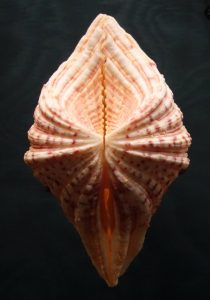 The genus Hippopus claims two species, H. hippopus (also known as the bear paw clam) and H. porcellanus (also known as the China clam). The latter species is the rarer of the two in the aquarium trade.
The genus Hippopus claims two species, H. hippopus (also known as the bear paw clam) and H. porcellanus (also known as the China clam). The latter species is the rarer of the two in the aquarium trade.
Hippopus clams may be encountered in the wild from the eastern Indian Ocean to western Australia and southern Japan (though H. porcellanus is mainly concentrated in the southwest Pacific). While they inhabit a variety of shallow (i.e. brightly lit) environments such as algal beds and seagrass meadows, they prefer sandy or gravelly reef flats.
In terms of maximum adult size, Hippopus species are somewhere in the middle of Tridacna. One notable distinction between Hippopus and Tridacna is that the former (especially in the adult stage) attaches to the substrate much less securely. While hippopus clams do lay down a few byssal threads (including mature specimens), they rely mainly on the weight of their big bodies to keep them in place.
Compared to Tridacna, the Hippopus mantle only reaches the upper edge of the shell. That is, it does not extend beyond the edge of the shell as in Tridacna. Also, in contrast to its cousins, the inhalant siphon (the opening where water is drawn into the body chamber) lacks tentacles around its margin (though it may have a rough edge). The exhalant siphon (the opening where water exits the body) has a comparatively lower profile than Tridacna and is more or less a bump with a small hole in it.
Hippopus Clams In the aquarium
For years, farmers focused on the flashy species from the genus Tridacna. And without a doubt, this effort was worthwhile, as these varieties (such as the blue or purple color morphs of T. maxima) are truly stunning. But, thankfully, farms have looked beyond the gaudy, eye-catching species and worked on some of the lesser seen tridacnid species such as those from the genus Hippopus. Though not as fancy as some of their glamorous relatives at first glance, hippopus clams are quite attractive and exotic looking in a way that grows on you more and more over time.
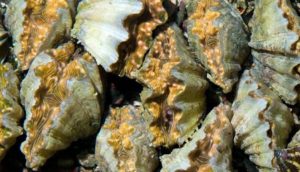 Their mantle is often golden hued with yellow squiggly lines, superficially resembling that of T. derasa. That being said, there is considerable variation of coloration in both species. Some bear a deep blue or green base color. Because the mantle is restricted to the span between the edge of the shell valves, the animal looks a little more “clammy” than its Tridacna counterparts. In fact, it looks somewhat split apart when gaping open.
Their mantle is often golden hued with yellow squiggly lines, superficially resembling that of T. derasa. That being said, there is considerable variation of coloration in both species. Some bear a deep blue or green base color. Because the mantle is restricted to the span between the edge of the shell valves, the animal looks a little more “clammy” than its Tridacna counterparts. In fact, it looks somewhat split apart when gaping open.
While some aquarists like the more flowy, oversized mantle of Tridacna, there’s something to be said of Hippopus in that it exposes and show off more of its handsome shell. Because its shell valves are highly symmetrical, the shell can (unlike some Tridacna species) close very tightly.
Another thing aquarists (especially reefkeepers with crowded tanks) might like about hippopus clams is that they actually prefer to rest on the tank floor over the substrate. Placing them is as simple as letting them settle onto an unshaded spot on the sand bed. It is, of course, always a good idea to ensure that frags and other poorly secured objects on the hardscape cannot fall onto them.
While Hippopus likes fairly bright light, it is not quite as picky in this regard as are T. maxima or T. crocea, for example. However, because of its ideal placement on the tank bottom, powerful aquarium lighting is strongly recommended (especially when kept in taller tanks).
Though the animal will obtain most of its food energy from its zooxanthellae, it benefits from frequent additions of quality live phytoplankton such as OceanMagik.
Conclusion
Hippopus clams offer something a little different than the “typical” tridacnid clam. They are most stark and robust in appearance. While their mantle colors are comparatively subdued, the rich, warm golden browns and beiges actually pop in an aquascape loaded with fluorescent purple and blue corals. The highly ornamental shell, mostly uncovered by the clam’s modest mantle, adds an interesting visual element to the tank bottom over a crisp white sand bed.
Best of all, now that these rarer gems are available as captive-bred, aquarists can show them off with relative ease of care!

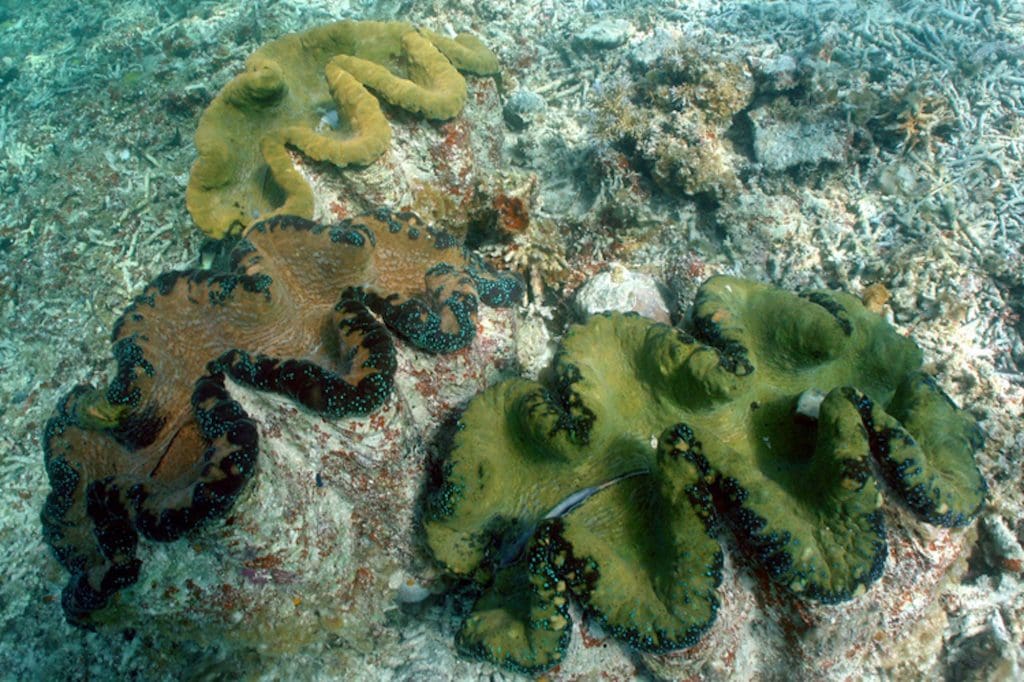
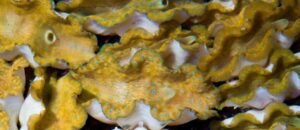
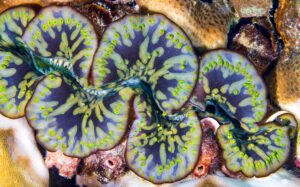
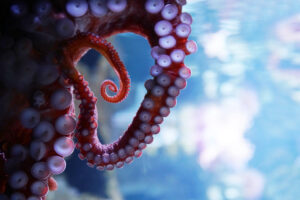

steve rivara says
210 gallon
Kirby Hughes says
Great info!
Scott Chase says
Only one I ever ordered years ago was DOA, need to try again on this species
pweiss989 says
Good info on this clam!!
Carlos Matias-Tejada says
beautiful shaped clam!
Douglas Ward says
Good info!
Patrick Pokrop says
Interesting info about the hippo clam!
adubvu says
So cool
shieldagent1 says
Grear info
straitmartin says
Nice!
shawn22vest says
Very good read here!
vmancine26 says
This clam is differente from most and easy to care for
ANTHONY CANDELORA says
Awsome looking clams
law says
My wife like the color blue better.
joshirwin2 says
So cool!
Ellery Wong says
I’ve have my current Hippopus for almost 2 years so far. The one I have is not gold but greyish looking mantle. Would like to collect a few more color variants.
joshuastevens930 says
Great read
Matthew Antolovich says
Good info for Michelle #2
MrBacony says
Interesting looking clam
dcreeron says
Maxima or Deresa for me
Tim Brown says
Too big for my 5 gallon nano.
Natalie Fernandez says
The patterns of this clam sort of remind me of my orange lepto coral!
Joe Willis says
I’ve never heard about hippopus clams before. Great info!
David Cruz says
Nice article!
heatherlv31 says
Great info
Jen FE DE LEON says
They have such a different shape than the other clams available, thanks for sharing!
Daniel Lenger says
always wanted to try these guys
Charles Folstrom says
Always great info
mitch.turner31 says
Awesome
Catherine says
Interesting!
Jennifer Kennedy says
I’ve never seen these before they have a very pretty porcelain looking shell, would be a beautiful contrast with a black sand substrate
laustinthought says
Helpful
laustinthought says
Helpful
jrosscollins87 says
Good stuff
Steve Miller says
I’ve never seen these before
Douglas Jordan says
Only a true pro can keep this
Michael Ehret says
interesting info!
Amanda Rasberry says
Good Info
coleman.j85 says
No way…
Daniel says
Just here for the price
thillock says
Not one of my favorite clams
hsmith5411 says
Nice!
Tejas Nair says
Wow I have never seen these in person before!
Erik Larsen says
Would love to get my hands on one
Nick Seunath says
Nice
shrimppyshrimp says
Nice clam
pastort.a.sherman says
Interesting
kmwagner91 says
Nice!
Travis Lund says
Way too big for my tank. Would love to see a full size one!
arthursu01@gmail.com says
Great article
jumpin.jack says
These sound like some cool rarer clams
alio1220000 says
Great read
Jahn Garcia says
Time for mine
co.reau says
This is fantastic information
Juan Perez says
So much stuff i didn’t know.
reefbeard says
Clamtastic!!!
obwhan says
I need a bigger tank
KRISTA FROST says
Too big
KRISTA FROST says
Too big
Troy says
When are they going to be back in stock?
joshirwin2 says
I’ve learned so much from this giveaway!
Eric says
I’ve been interested in these clams due to their unique shape, but their final size and weight has made me hesitant.